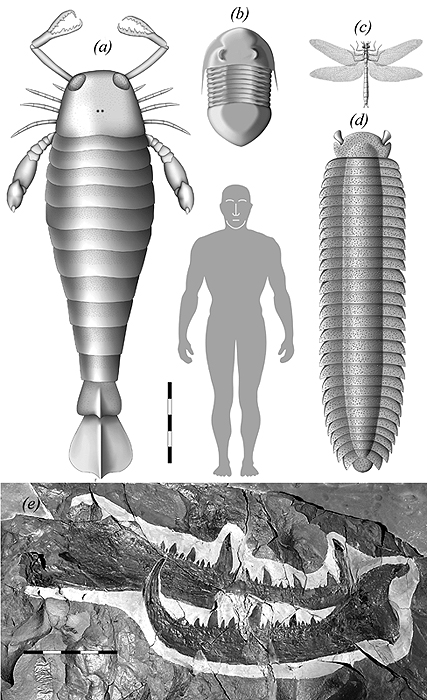 |
 |
 |
 |
 |
Produced
by the Population Genetics and Evolution class, Furman University |
||||
 |
 |
 |
 |
 |
Produced
by the Population Genetics and Evolution class, Furman University |
||||
 |
The
Devonian: Jaekelopterus |
 |
||
| Jaekelopterus
rhenaniae is a species of Eurypterid (sea scorpion), which grew up
to 2.5 meters long, making it the largest arthropod that ever lived. They
were believed to be much smaller until the discovery of a 46cm claw (Braddy
et al. 2008). This sort of gigantism in aquatic taxa is not completely
understood, but has been attributed to elevated atmospheric oxygen levels,
environmental resources, predation, and competition. Because oxygen levels
are not unusually high in the Devonian, most scientist believe that their
huge size correlates with adaptating to life as a super-predator. Eurypterids
are segmented and divided into two body parts, the prosoma and opisthosoma.
They are the sister group of scorpions, and some smaller eurypterids were
probably the first animals to venture onto land. The first pair of appendages,
known as the chelicerae, are homologous to the fangs of spiders rather
than the pincers of scorpions (Waggoner 1995). In species like Jaekelopterus
rhenaniae the chelicerae have been adapted into large prey-catching
organs, placing them at the top of their food chain. Page by Megan Aprill |
 |
| Jaekelopterus rhenaniae compared to the largest trilobite(b), the largest dragonfly Meganeura (c), and the largest millipede Arthopleura (d), with the fossil pinchers, below. Photo credit: Yale University. | |
| Braddy SJ, Poschmann M, Tetlie OE. 2008. Giant claw reveals the largest ever arthropod. Biol Lett 2: 106-109. Accessed February 23, 2010. Khamsi R. 2007.Giant claw points to monster sea scorpion. New Scientist. Accessed February 23, 2010. Waggoner B. 1995. Eurypterida: Morphology. University of California Museum of Paleontology (UCMP). Accessed February 23, 2010 |